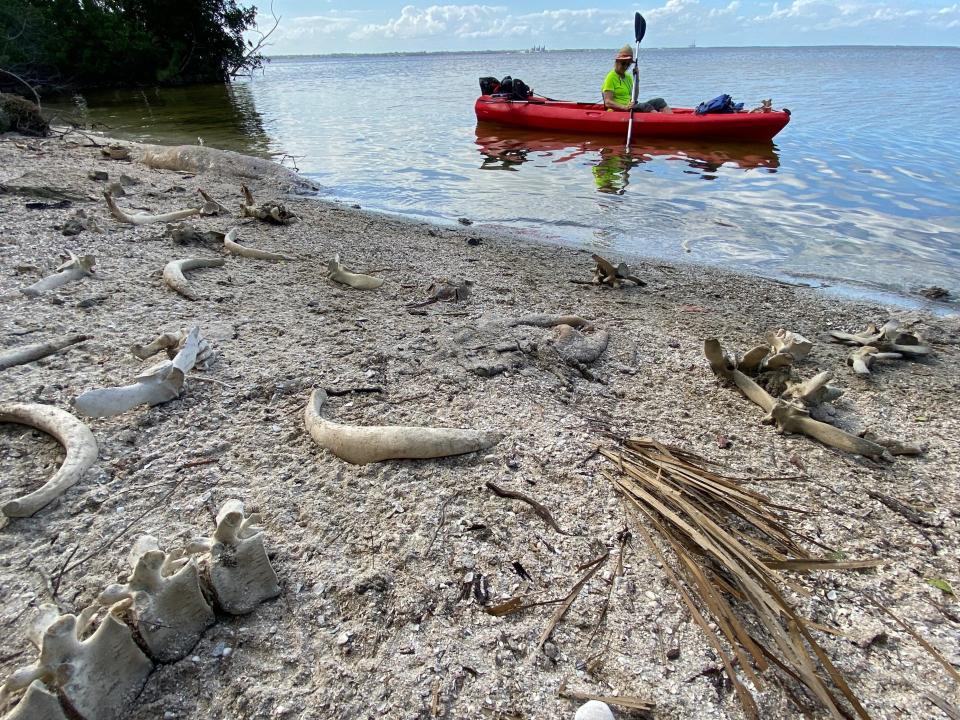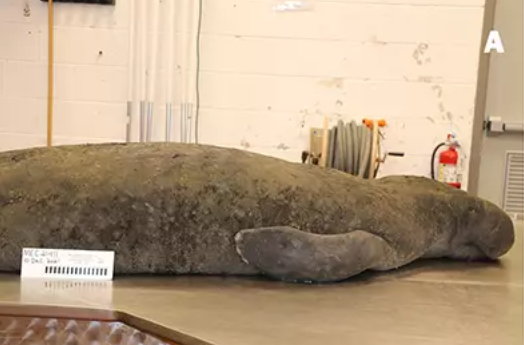Climate change: Efforts to reduce global warming hurting manatees in an unusual way
The zeal to tame and conquer Florida’s wilds and waterways has left one of its most beloved creatures slashed, starved and now potentially frozen in a collision of corrupted lands and efforts to slow global warming.
Historically, cold-fragile manatees flocked in winter to tepid natural springs, warm basins and coastal pockets where sun-heated water sheeted off yawning landscapes. Development spoiled those age-old refuges by blocking access to springs, depleting ground water sources and cutting off coastal flows.
More than half of Florida’s manatees have since found shelter during the darkest and chilliest days of the year huddling in the balmy discharges from the state’s power plants, according to the Florida Fish and Wildlife Conservation Commission.
Where to see manatees this winter: West Palm Beach's Manatee Lagoon holds kickoff celebration
But a move to alternative energies to mitigate climate change means many of those warm water releases may go offline over the next several decades, leaving hapless manatees who depend on the life-sustaining flows out in the cold.
Wildlife managers to hear about potential solution to help manatees keep warm
The FWC Commission will hear about a move to jump-start a 20-year-old warm-water manatee plan at its Feb. 21-22 meeting in Tallahassee.
Time is of the essence.
“The magnitude of this undertaking is considerable,” the plan notes. “We must begin now to avoid catastrophic losses of the Florida manatee population.”
Scores of manatees are killed each year by the slicing blades of boat propellers, and a recent seagrass die off left a record number of the friendly sea cows dead by starvation. Dying by cold can be more random depending on Mother Nature's caprice, but state biologists warn in the warm-water plan that manatee populations could decline by at least 30% over the coming century largely because of the loss of cold-weather refuges.
Patrick Rose, an aquatic biologist and executive director of Save the Manatee Club, said manatees generally need water temperatures of 68 degrees or warmer to survive, although healthy adult animals can withstand cooler temperatures for brief periods of time.
Manatees, while rotund, don’t have a complete blubber layer like whales, Rose said. When water temperatures cool, they stop digesting food, living off fat reserves instead. Periods of prolonged cold or an extreme cold shock causes their organs to shut down and, eventually, they die of cold stress.
“About 60% of the manatee population is depending on the warm water sources from power plants, so we have to find a way to wean them off the artificial warm water while securing the springs and aquifers that the other 40% are depending on,” Rose said. “There is no simple solution to it.”
Climate change is heating up the planet but there will still be winters
While climate change is blamed for overall warming temperatures, cold snaps do, and will, still happen.
A 2002 report from the U.S. Environmental Protection Agency found that nine of the top 10 warmest years on record for the continental United States have occurred since 1998. It also noted that average temperatures have risen more quickly since the late 1970s.
Emaciated and near death: Tale of Chessie the traveling manatee nearly ends, but there's more to his story
Still, unusually cold winter months in 2010 were blamed for what was then record high manatee mortality rates. Average temperatures in January were between 4 and nearly 7 degrees below normal from Key West to Pensacola, according to the Florida Climate Center. The following December was even cooler, with average temperatures 7 to 11 degrees below normal.
By the end of the year, 767 manatees had died, with nearly 300 deaths directly attributed to cold stress. The cold likely contributed to another 280 or more deaths, state biologists said at the time.
“It’s hard to find a good balance between infrastructure, nature and wildlife,” said Amanda Prieto, senior program director for Miami Waterkeeper. “But I think there is still a chance that we can take critical steps to improve the likelihood of having enough warm-water refuges in the future.”
Cleaner energy sources mean colder winters for manatees
Florida fish and wildlife officials and the U.S. Fish and Wildlife Service are making the warm-water planning for manatees a priority after groups working on it were disbanded about a decade ago, Rose said. A Florida Manatee Warm-Water Habitat Action Plan was developed in 2004 and updated in 2020.
According to unpublished data from the state's Florida Fish and Wildlife Research Institute that is referenced in the plan, warm water springs are better winter refuges for manatees than power plants. Winter temperatures in springs range from 70 to 73 degrees, while power plant discharges can drop to 68 degrees or lower during the coldest months.
Statewide, there are 67 primary and secondary warm water sites that manatees use, including 10 power plants.
It was in the 1950s that power plants began to grow along Florida’s soft outer fringes, using coastal waters to cool their facilities and unwittingly providing new habitat for manatees.
Older plants have since shut down, and a push toward cleaner and alternative energies has led to the repowering of others.
Florida Power and Light’s Riviera Beach facility underwent a $1.3 billion modernization in 2014, allowing it to use natural gas. It replaced a 1960s-era oil-fired plant that was demolished in 2011.
FPL has also repowered Cape Canaveral Energy Center and the Port Everglades Energy Center.
The new plants offer a “short-term level of security” that warm-water discharges will be available for years to come, but the more efficient plants produce a lesser volume of warm water, shrinking the warm-water refuges by as much as 25%, the state manatee plan says.
Alternative energies: Battery storage 'necessary component' to electric utilities' solar power expansion
“We have to move away from carbon production if we are going to manage global warming,” Rose said. “That means virtually all the warm-water (power plant) refuges manatees are habituated to will effectively have to be eliminated.”
The state estimates there are approximately 8,300 to 11,700 manatees in Florida waters. They were downgraded by the federal government in 2017 from endangered to threatened, which reduced their protections. Although an October decision to reconsider the downgrade has boosted optimism among environmentalists, manatees have suffered greatly in the past six years.
A loss of seagrasses caused by chronic pollution in the Indian River Lagoon triggered mass starvations beginning in 2020 that left scores of manatee corpses — deflated and fed upon by vultures ― littering spill islands.

A total of 1,100 manatees died in 2021 with another 800 in 2022. In comparison, between 2017 and 2020, the average number of manatee deaths each year was 650.
Wildlife officials began a supplemental feeding program in 2021. That ended in December when enough seagrasses grew back to sustain the manatees through the winter.

Making more warm water for manatees
Efforts to keep enough warm-water habitats include maintaining current natural springs and thermal basins used by manatees in winter and undoing the damage caused to those that can no longer be used.
"We're not opposed to creating new habitat, but there are existing springs that could be restored to support them," Prieto said.
In 2015, a joint federal and state project created a warm-water habitat in the Fakahatchee Strand Preserve State Park near Everglades City. It consisted of a U-shaped inlet off a canal that connected to three deep water pools. The deeper pools help manatees get closer to warm ground water in the winter months.
“This is going to require the acquisition of land, pilot studies, and it’s going to be expensive on top of everything else,” Rose said about creating more warm-water sites. “We could have made and should have made more progress before now.”
Kimberly Miller is a veteran journalist for The Palm Beach Post, part of the USA Today Network of Florida. She covers real estate and how growth affects South Florida's environment. Subscribe to The Dirt for a weekly real estate roundup. If you have news tips, please send them to kmiller@pbpost.com. Help support our local journalism, subscribe today.
This article originally appeared on Palm Beach Post: Fighting climate change hurts Florida manatees as power plants go offline

